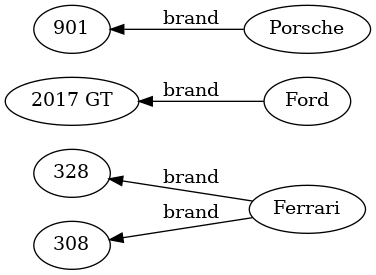SimpleGraph-MapSystem
Jump to navigation
Jump to search

SimpleGraphModule
SimpleGraph MapSystem module
The SimpleGraph MapSystem module supplies a simple wrapper for a graph with nodes that have key/value pairs in form of HashMaps. We would not really need this since Apache Tinkerpop/Gremlin already supplies us with properties per node/vertex. Still this system is useful as a helper system and to illustrate the wrapping concepts and possibilities of SimpleGraph see java.api.Map.
Sources
- System: MapSystem.java
- JUnit-Test: TestMapSystem.java
Freitext
Example
Goal
We'd like to create a tree of carbrands with corresponding car makes.
Result
CarGraph
The nodes of this graph are clickable and will lead you to the wikidata pages of the carmakes and carbrands.

Explanation
The following JUnit Test source code is commented with the explanation on how the MapSystem works.
@Test
public void testMapSystem() throws Exception {
// create a map system and connect to init
MapSystem ms=new MapSystem();
ms.connect();
// init some maps of carbrands and cars each map shall later represent a
// vertex in the graph with it's properties
Map[] carbrandmaps= {
initMap("name","Ferrari","country","Italy","wikidataid","Q27586"),
initMap("name","Porsche","country","Germany","wikidataid","Q40993"),
initMap("name","Ford","country","United States","wikidataid","Q44294")
};
Map[] carmakemaps= {
initMap("name","308","year",1984,"wikidataid","Q1407659","brand","Ferrari"),
initMap("name","328","year",1989,"wikidataid","Q1407669","brand","Ferrari"),
initMap("name","901","year",1964,"wikidataid","Q2104537","brand","Porsche"),
initMap("name","2017 GT","year",2017,"wikidataid","Q23856323","brand","Ford")
};
// create MapNodes with the given kind "carbrand" or "car" based on the maps
MapNode startNode=null;
for (Map map:carbrandmaps) {
startNode=new MapNode(ms,"carbrand",map);
}
for (Map map:carmakemaps) {
MapNode mapNode=new MapNode(ms,"car",map);
// link the node of this car to it's carbrand node using the Gremlin graph traversal
// language - this is the key action for this example
ms.g().V().hasLabel("carbrand").has("name",map.get("brand")).forEachRemaining(brandNode->{
brandNode.addEdge("brand", mapNode.getVertex());
});
}
// set a start node for the system
// any node will do and for this example it is not really necessary - each node
// has the full graph accesible
ms.setStartNode(startNode);
// uncomment if you'd like to see all the node details
// debug=true;
if (debug)
ms.g().V().forEachRemaining(SimpleNode.printDebug);
// generate a graphviz graph based on this start node
// show the "brand" edges
// show the "name" for each node
// use wikidataid as the identifier
// and extend to a full url using the WIKIDATA_URL_PREFIX
// use the rankDir RL = right left
// and name the graph "CarGraph"
String graphViz = TestRythm.generateGraphViz(ms.getStartNode(), "brand", "name", "wikidataid",
WIKIDATA_URL_PREFIX,"RL","CarGraph");
// uncomment if you'd like to see the graph source code
// the rendered graph is available at http://www.bitplan.com/index.php?title=SimpleGraph#CarGraph
// debug = true;
if (debug)
System.out.println(graphViz.trim());
// check that the graph contains one of the expected graphviz code lines
assertTrue(graphViz.contains("\"Q27586\" [ label=\"Ferrari\" URL=\"https://www.wikidata.org/wiki/Q27586\"]"));
}